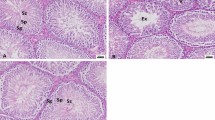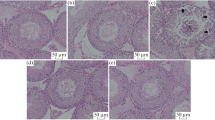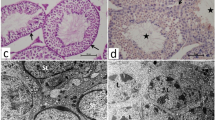Abstract
The antioxidant protective effects of gallic acid (GAL) and quercetin (QUE) against oxidative stress induced by di-butyl phthalate (DnBP) in the liver and testis of rats were evaluated in this study. Adult albino Wistar rats (180–225 g) were treated with QUE or GAL (50 mg/kg) alone or in combination with DnBP (1 mL/kg) for 15 days. After treatment, tissue samples were taken for determination of glutathione and malondialdehyde levels, and superoxide dismutase and catalase activities. Serial sections of the testis and liver were stained with haematoxylin and eosin for microscopy and seminiferous tubular morphometry. As expected, DnBP induced oxidative stress was evident by increased malondialdehyde level in both organs. Co-treatment with GAL or QUE reversed the malondialdehyde by 45.42, 37.44 and 37.57%, 23.32% and catalase by 52.21, 70.15 and 85%, 38.14% in the testis and liver respectively whereas superoxide dismutase activity and glutathione level were differently modulated parallel to histopathological improvement in both tissues. The seminiferous tubular diameter, epithelial height, epithelial germ cell count and tubular length were significantly decreased by 11.09, 51.91, 40.65 and 11.10% respectively versus control values after DnBP treatments and were attenuated on co-treatment with GAL or QUE. Co-treatment with GAL afforded better protective effects in both tissues but QUE treatment alone appeared more effective than GAL on the investigated morphometric data. It seems likely that GAL or QUE prevented the tissue damage but the antioxidant profiles of the liver and testis are different in response to the oxidative stress.








Similar content being viewed by others
References
Muczynski V, Lecureuil C, Messiaen S, Guerquin MJ, N’tumba-Byn T, Moison D, et al. Cellular and molecular effect of MEHP involving LXRα in human fetal testis and ovary. PLoS ONE. 2012;7:e48266.
Farombi EO, Abarikwu SO, Adedara IA, Oyeyemi MO. Kolaviron and curcumin ameliorate di-n-butylphthalate-induced testicular toxicity in rats. Basic Clin Pharmacol Toxicol. 2007;100:43–8.
Abd-Ellah MF, Aly HAA, Mokhlis HAM, Abdel-Aziz AH. Quercetin attenuates di-(2 ethylhexyl) phthalate-induced testicular toxicity in adult rats. Hum Exp Toxicol. 2016;35:232–43.
Abarikwu SO, Pant AB, Farombi EO. Quercetin decreases steroidogenic enzyme activity, NF-κB expression and oxidative stress in cultured Leydig cells exposed to atrazine. Mol Cell Biochem. 2013;373:19–28.
Kuppan G, Balasubramanyam J, Monickaraj F, Srinivasan G, Mohan V, Balasubramanyam M. Transcriptional regulation of cytokines and oxidative stress by gallic acid in human THP-1 monocytes. Cytokine. 2010;49:229–34.
Li D, Liu Z, Zhao W, Xi Y, Niu F. A straightforward method to determine the cytocidal and cytopathic effects of the functional groups of gallic acid. Process Biochem. 2011;46:2210–4.
Prasad L, Khan TH, Jahangir T, Sultana S. Effect of gallic acid on renal bio- chemical alterations in male Wistar rats induced by ferric nitriloacetic acid. Hum Exp Toxicol. 2006;25:523–9.
Choi EJ, Lee BH, Lee K, Chee KM. Long-term combined administration of quercetin and daidzein inhibits quercetin-induced suppression of glutathione antioxidant defences. Food Chem Toxicol. 2005;43:793–8.
Kaindl U, Eyberg I, Rohr-Udilova N, Heinzle C, Marian B. The dietary antioxidants resveratrol and quercetin protect cells from exogenous pro-oxidative damage. Food Chem Toxicol. 2008;46:1320–6.
Ansari MA, Abdul HM, Joshi G, Opii WO, Butterfield DA. Protective effect of quercetin in primary neurons against Abeta (1–42): relevance to Alzheimer’s disease. J Nutr Biochem. 2009;20:269–75.
Abarikwu SO, Farombi EO. Quercetin ameliorates atrazine-induced changes in the testicular function of rats. Toxicol Ind Health. 2016;32:1278–85.
Baltaci BB, Uygur R, Caglar V, Aktas C, Aydin M, Ozen OA. Protective effects of quercetin against arsenic-induced testicular damage in rats. Andrologia. 2016;48:1202–13.
Farombi EO, Abarikwu SO, Adesiyan AC, Oyejola TO. Quercetin exacerbates the effects of sub-acute treatment of atrazine on reproductive tissue antioxidant defence system, lipid peroxidation and sperm quality in rats. Andrologia. 2013;45:256–65.
Abarikwu SO, Durojaiye M, Alabi A, Asonye B, Akiri O. Curcumin protects against gallic acid-induced oxidative stress, suppression of glutathione antioxidant defences, and hepatic and renal damage in rats. Ren Fail. 2015;38:321–9.
Abarikwu SO, Durojaiye MA, Alabi AF, Akiri OF. Combined administration of curcumin and gallic acid inhibits gallic acid-induced suppression of steroidogenesis, sperm output, antioxidant defences and inflammatory responsive genes. J Steroid Biochem Mol Biol. 2014;143:49–60.
Jahan S, Ain QU, Ullah H. Therapeutic effects of quercetin against bisphenol A induced testicular damage in male Sprague Dawley rats. Syst Biol Reprod Med. 2016;62:114–24.
Li L, Ng TB, Gao W, Li W, Fu M, Niu SM. Antioxidant activity of gallic acid from rose flowers in senescence accelerated mice. Life Sci. 2005;77:230–40.
Jaiswal N, Rizvi SI. Onion extract (Allium cepa L.) quercetin and catechin up-regulate paraxonase 1 activity with concomitant protection against low density lipoprotein oxidation in male Wistar rats subjected to oxidative stress. J Sci Food Agric. 2014;94:2752–7.
Vijaya Padma P, Sowmya T, Arun Felix R, Baskaran P, Poornima P. Protective effect of gallic acid against lindane induced toxicity in experimental rats. Food Chem Toxicol. 2011;49:991–8.
Olayinka ET, Ore A, Ola OS, Adeyemo OA. Protective effect of quercetin on melphalan-induced oxidative stress and impaired renal and hepatic functions in rat. Chemother Res Pract. 2014;2014:936526.
Ohkawa H, Ohishi N, Yagi K. Assay for lipid peroxides in animal tissues by thiobarbituric acid reaction. Anal Biochem. 1979;95:351–8.
Sedlak J, Lindsay RH. Estimation of total, protein bound, and non-protein sulfhydryl groups in tissue with Ellman’s reagent. Anal Biochem. 1968;25:192–205.
Misra HP, Fridovich I. The role of superoxide anion in the autooxidation of epinephrine and a simple assay for superoxide dismutase. J Biol Chem. 1972;247:3170–5.
Clairborne A. Catalase activity. In: Greewald AR, editor. Handbook of methods for oxygen radical research. Boca Raton: CRC Press Ltd; 1995, pp. 237–42.
Lowry OH, Rosenbrough NJ, Farr AL, Randall RJ. Protein measurement with Folin phenol reagent. J Biol Chem. 1951;193:265–75.
Morais DB, Barros MS, Paula TAR, Freitas MBD, Gomes MLM, Matta SLP. Evaluation of the cell population of the seminiferous epithelium and spermatic indexes of the bat Sturnira lilium (Chiroptera: Phyllostomidae). PLoS ONE. 2014;9:e101759.
Ryu JY, Lee E, Kim HJ, Park H, Im JY, Kim J, et al. Alterations of di(n-butyl) phthalate-induced oxidative stress in the testis of hypothyroid rats. Toxicol Environ Chem. 2008;90:113–26.
Zhou D, Wang H, Zhang J. Di-n-butylphthalate (DBP) exposure induces oxidative stress in epididymis of adult rats. Toxicol Ind Health. 2011;27:65–71.
Zuo HX, Li JQ, Han B, Ke CJ, Liu XD, Zhang YC, et al. Di-(n-butyl)-phthalate-induced oxidative stress and depression-like behaviour in mice with or without ovalbumin immunization. Biomed Environ Sci. 2014;27:268–80.
Aly HA, Hassan MH, Beshbishy HA, Alahdal AM, Osman AM. Dibutyl phthalate induces oxidative stress and impairs spermatogenesis in adult rats. Toxicol Ind Health. 2016;32:1467–77.
Abarikwu SO, Benjamin S, Ebah SG, Obilor G, Agbam G. Protective effect of Moringa oleifera oil against HgCl2-induced hepato- and nephro-toxicity in rats. J Basic Clin Pharmacol Physiol. 2017;28:337–45.
Kwack SJ, Han EY, Park JS, Bae JY, Ahn IY, Lim SK, et al. Comparison of the short term toxicity of phthalate diesters and monoesters in sprague-dawley male rats. Toxicol Res. 2010;26:75–82.
Ferguson KK, Loch-Caruso R, Meeker JD. Exploration of oxidative stress and inflammatory markers in relation to urinary phthalate metabolites: NHANES 1999–2006. Environ Sci Technol. 2012;46:477–85.
Majeed KA, Ur Rehman H, Yousaf MS, Zaneb H, Rabbani I, Tahir SK, et al. Sub chronic exposure to low concentration of dibutyl phthalate affects anthropometric parameters and markers of obesity in rats. Environ Sci. 2017;24:25462–7.
Abo-Salem OM, Abd-Ellah MF, Ghonaim MM. Hepatoprotective activity of quercetin against acrylonitrile-induced hepatotoxicity in rats. J Biochem Mol Toxicol. 2011;25:386–92.
Nabavi SF, Nabavi SM, Habtemariam S, Moghaddam AH, Sureda A, Jafari M, et al. Hepatoprotective effect of gallic acid isolated from Peltiphyllum peltatum against sodium fluoride-induced oxidative stress. Ind Crops Prod. 2013;44:50–5.
Dehghani F, Hassanpour A, Poost-Pasand A, Noorafshan A, Karbalay-Doust S. Protective effects of L-carnitine and homogenized testis tissue on the testis and sperm parameters of busulfan-induced infertile male rats. Iran J Reprod Med. 2013;11:693–704.
Nna VU, Ujah GA, Mohamed M, Etim KB, Igba BO, Augustine ER, et al. Cadmium chloride–induced testicular toxicity in male Wistar rats; prophylactic effect of quercetin, and assessment of testicular recovery following cadmium chloride withdrawal. Biomed Pharmacother. 2017;94:109–23.
Azu OO, Naidu EC, Naidu JS, Masia T, Nzemande NF, Chuturgoon A, et al. Testicular histomorphologic and stereological alterations following short-term treatment with highly active antiretroviral drugs (HAART) in an experimental animal model. Andrology. 2014;2:772–9.
Zhou D, Wang H, Zhang J, Gao X, Zhao W, Zheng Y. Di-n-butyl phthalate (DBP) exposure induces oxidative damage in testes of adult rats. Syst Biol Reprod Med. 2010;56:413–9.
Zhang L-D, Li C-H, Chong T, Gao M, Yin J, Fu D-L, et al. Pre-pubertal exposure to genistein alleviates di-(2-ethylhexyl) phthalate induced testicular oxidative stress in adult rats. Biomed Int. 2014;2014:598630.
Ciftci O, Aydin M, Ozdemir I, Vardi N. Quercetin prevents 2, 3, 7, 8-tetrachlorodibenzo-p-dioxininduced testicular damage in rats. Andrologia. 2012;44:164–73.
Oyagbemi AA, Omobowale TO, Saba AB, Adedara IA, Olowu ER, Akinrinde AS, et al. Gallic acid protects against cyclophosphamide-induced toxicity and epididymis of rats. Andrologia. 2016;48:393–401.
Taepongsorat L, Tangpraprutgul P, Kitana N, Malaivijitnond S. Stimulating effects of quercetin on sperm quality and reproductive organs in adult male rats. Asian J Androl. 2008;10:249–58.
Vander Woude H, Tar Veld MG, Jacob N, Vaan Der Saag PT, Murk AJ, Riet Jen IM. The stimulation of cell proliferation by quercetin is mediated by estrogen receptor. Mol Nutr Food Res. 2005;49:763–71.
Jahan S, Iftikhar N, Ullah H, Rukh G, Hussain I. Alleviative effect of quercetin on rat testis against arsenic: a histological and biochemical study. Syst Biol Reprod Med. 2015;61:89–95.
Hidalgo M, Martin-Santamaria S, Recio I, Sanchez-Moreno C, de Pascual-Teresa B, Rimbach G, et al. Potential anti-inflammatory, anti-adhesive, anti/estrogenic, and angiotensin-converting enzyme inhibitory activities of anthocyanins and their gut metabolites. Genes Nutr. 2012;7:295–306.
Dogrul NB, Kiliccalan I, Samet AE. The protective effect of gallic acid against endocrine disrupting damages of bisphenol A and possible mechanism. J Contemp Med Educ. 2016;4:39.
Abarikwu SO, Njoku RC, Lawrence CJ, Charles IA, Ikewuchi JC. Rutin ameliorates oxidative stress and preserves hepatic and renal functions following exposure to cadmium and ethanol. Pharm Biol. 2017;55:2161–9.
Nelson SK, Bose SK, Grunwald GK, Myhill P, McCord JM. The induction of human superoxide dismutase and catalase in vivo: a fundamentally new approach to antioxidant therapy. Free Radic Biol Med. 2006;40:341–7.
Bouayed J, Bohn T. Exogenous antioxidants-Double-edged swords in cellular redox state: health beneficial effects at physiologic doses versus deleterious effects at high doses. Oxid Med Cell Longev. 2010;3:228–37.
Abarikwu SO. Protective effect of quercetin on atrazine induced oxidative stress in the liver, kidney, brain and heart of adult Wistar rats. Toxicol Int. 2014;21:148–55.
Abarikwu SO, Pant AB, Farombi EO. Dietary antioxidant, quercetin, protect Sertoli-germ cell co-culture from atrazine-induced oxidative damage. J Biochem Mol Toxicol. 2012;26:477–85.
Abarikwu SO, Akiri OF, Durojaiye MA, Alabi AF. Combined effects of repeated administration of Bretmont Wipeout (Glyphosate) and Ultrazin (Atrazine) on testosterone, oxidative stress and sperm quality of Wistar rats. Toxicol Mech Methods. 2015;25:70–80.
Lu Z, Nie G, Belton PS, Tang H, Zhao B. Structure-activity relationship analysis of antioxidant ability and neuroprotective effect of gallic acid derivatives. Neurochem Int. 2006;48:263–74.
Acknowledgements
We thank Mr Christian Kingsley Nwaugha for the collection of blood samples from the animals used in this study, as well as Messrs Tochukwu Anthony Nnadiukwu and Ohanador Olisa Robinson for their technical assistance in the handling of the equipment used in this study.
Funding
This research received no specific grant from any funding agency in the public, commercial or not-for-profit sectors.
Author information
Authors and Affiliations
Contributions
SOA designed the study, supervised experiments, interpreted data and wrote the manuscript; GS performed experiments and participated in the design; CSO supervised experiments and participated in the design.
Corresponding author
Ethics declarations
Conflict of interest
All authors of this manuscript are aware of this submission and declare no conflict of interest.
Ethical Approval
All applicable institutional and international guidelines for the care, handling and use of animals were followed.
Rights and permissions
About this article
Cite this article
Abarikwu, S.O., Simple, G. & Onuoha, C.S. Morphometric Evaluation of the Seminiferous Tubules and the Antioxidant Protective Effects of Gallic Acid and Quercetin in the Testis and Liver of Butyl Phthalate Treated Rats. Ind J Clin Biochem 35, 20–31 (2020). https://doi.org/10.1007/s12291-018-0788-0
Received:
Accepted:
Published:
Issue Date:
DOI: https://doi.org/10.1007/s12291-018-0788-0




